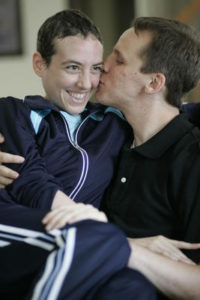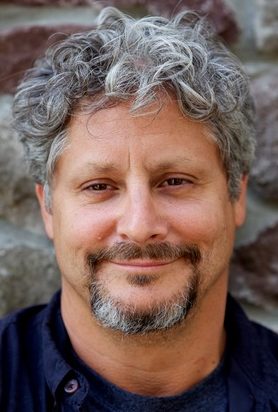By Victor Greto
When Richard Deede asked Jill Sabsevitz to marry him last year, he did it the old-fashioned way – on one knee, and at the place where he first laid eyes on her, at the corner of Main and Academy streets on the University of Delaware campus.
It was April and drizzling and the thick clouds made it dark, but when he slipped the carefully chosen 1-carat diamond on the ring-finger of her left hand, it fit perfectly.

Everything seemed right, despite the weather, despite the small argument they had debating whether it was even the right corner.
In fact, they argued about it before she said yes and kept gawking at the ring.
But both knew they wanted to get married.
After dating for four years during college; separating while she attended graduate school in Albany, N.Y., on her way to becoming a clinical psychologist; and then breaking up for nearly a year, Jill was more than ready to commit.
“I discovered I didn’t like being without him,” says Jill, 28.
After hesitating when Jill contacted him less than a year after their break-up, Richard, 27, became sure, too.
Like every excited couple about to marry, all that uncertainty seemed curiously pointless when they decided to officially commit to each other.
All that vacillation became absurd eight months later when Jill was diagnosed with acute myeloid leukemia, a deadly disease. The disease has precariously suspended their imagined future of two or three children, a dog, a home between their parents’ houses in New Jersey and Wilmington, and professional careers.
Richard’s mother Ann Phillips says her son cannot imagine a life without Jill.
That’s why she is putting together a bone marrow drive for her “soon-to-be-daughter-in-law,” as the two families desperately try to find a perfect genetic “match” so Jill has a better chance to live.
“I not only want to save Jill,” Ann says, “but also Richard’s dream.”
****
A week before the April drizzle, Jill had wanted to ask Richard to marry her.
She even asked him one day what he thought about women proposing to men.
“But I had been planning it for months,” Richard says. The ring had to be perfect, and he had to get her to that corner of the campus where they had first met to do it right.
When the engaged couple drove back to Richard’s parents’ home in north Wilmington, his stepfather already had put up a homemade sign on the door: “It’s about friggin’ time.”
“She called her mom, and my parents had a toast for us,” Richard says.
“We spent the night together at my place,” a home near Trolley Square Richard had bought months before.
Jill moved in with Richard in July.
Jill’s mother, Debbie, who lives with husband Arthur in Monroe Township in central New Jersey, began planning for an October 29, 2006, wedding for her only daughter. She already had booked the band, the location, and the rabbi.
In November, Jill had had her wisdom teeth pulled. While recovering, she experienced night fevers, and her body ached constantly.
Her family doctor told Jill it probably was some virus, but another doctor performed blood work on her, and quickly called the couple in to her office.
“She told me it looked like cancer,” Jill says.
Jill checked in to Christiana Hospital on Dec. 22, and was diagnosed with acute myeloid leukemia, a quickly-progressing disease in which too many immature white blood cells are found in the blood and bone marrow, destroying the immune system.
Only about 4,000 people are diagnosed with this form of leukemia each year.
The next day, Jill was airlifted by helicopter to Johns Hopkins Medical Center in Baltimore, where she mostly has lived for the past six months.
When Jill entered Johns Hopkins, doctors found that her bone marrow had been completely replaced by leukemia, cells that neither mature nor die.
The aim of chemotherapy treatments is to return the cells to normalcy, to mature and die and be replaced by healthy cells.
“We were able to get rid of some, but we couldn’t get rid of it all,” says Dr. Judith Karp, who has supervised Jill’s treatments at Johns Hopkins.
For people Jill’s age, there’s an 85 percent chance of complete remission. But despite three treatments, that hasn’t happened.
“This leukemia is completely resistant to all of the best chemotherapies we have thrown at it so far,” Karp says.
Jill is now undergoing her fourth experimental treatment.
The families also are looking into a more radical experimental method being in Minnesota, which uses umbilical cord stem cells.
Once the leukemia is in remission, the family wants Jill to have a bone marrow transplant, which will cost up to $400,000.
Although Karp says a transplant “only is another modality in our armature against the disease,” the families believe it will save her.
Out of a worldwide database of more than 10 million potential donors, they have yet to find a perfect match for Jill.
Her two older brothers, Barry and David, are perfect matches for each other, but only half-matches for their sister.
And because the treatments have not reduced the leukemia to a low enough point, that’s not good enough.
“The chances of a transplant working are significantly greater when the leukemia itself is in some type of remission,” Karp says.
“I should have had a couple of more kids,” Debbie says.
****
Jill’s engagement ring no longer fits her finger.
She has lost nearly 15 pounds and is down to about 94 pounds. Richard has since bought her a sized-down topaz stone that fits.
Jill’s long coal-black hair has fallen out three separate times after weeks-long chemotherapy treatments. When it grows back, its thick strands look like tines curling around her small skull.
Each time her hair grows back, it seems softer. Her family likes to run their fingers through it. Even Richard can’t help himself
“It’s so soft,” he says.
“I prefer a treat after it’s touched,” Jill says.
Before her first treatment, Jill’s mother, Debbie, had cut Jill’s hair short in anticipation of her losing it.
“I keep it in my room,” she says.
Like her daughter, Debbie also has lost about 15 pounds.
“It smells like her,” she says of Jill’s cut hair, “that powder smell. Is that weird?”
“It’s creepy,” Jill says.
Not when seen against everything else Debbie has saved of her daughter’s, including baby books and photo albums containing the pictures of every conceivable moment of her only daughter’s life.
“After the two boys, I wanted a girl,” Debbie says. “Arthur said after this one, that was it. So, when I woke up (after giving birth), and they told me she was a girl, I was jumping off the bed with excitement.”
For a few precious days between the weeks of treatment in Baltimore, Jill comes to her parents’ home in New Jersey.
It’s a cleaner, more sterile home than the one she shared with Richard at Trolley Square. Richard stays with Jill’s family when Jill is there, as do her two brothers when they can get away from work.
They watch movies together, play Texas Hold-em, or putt-putt golf if Jill feels up to going out. If she does go out, she wears a surgical mask over her face to prevent breathing in germs.
Neighbors held a poker fund-raiser for Jill. Richard has held fundraisers at his job, Avenue A-Razor Fish, a Internet marketing company in Philadelphia, where he is a computer programmer. There have been at least two bone marrow drives in New Jersey.
The helicopter ride that took Jill to Johns Hopkins alone cost $10,000. They’re battling the insurance company to pay for it.
Then there’s the cost of the bone marrow transplant. Richard’s insurance will pay up to $250,000 of the $400,000 cost. And that’s only for the first one.
****
Richard’s family is helping sponsor a bone marrow drive at the Jewish Community Center on Garden of Eden Road off Concord Pike on July 18.
In a bone marrow drive, blood type doesn’t matter. The initial test only involves a cheek swab.
Because tissue type is inherited, Jill’s best chance of finding a genetically matched bone-marrow donor lies with those of Eastern-European Jewish ancestry.
“Everything changes from day to day,” Jill says of her health. “The only thing I know is the bone marrow. All else is uncertain.”
Whoever is a match, Jill, who began practicing psychological therapy for a few short months before she was diagnosed, promises to give him or her free therapy sessions for the rest of their life.
“I thought she would become my daughter after they got married,” says Richard’s mother, Ann Phillips. “She already is.”
Ann’s son, Aaron Deede, suffered brain damage and paralysis from the chest down six years ago when he lost control of his car driving north on Del. 141 and hit a curb and then a telephone pole.
“In some ways he lost the brother he knew when Aaron had the accident,” Phillips says. “But when Jill got the diagnosis, one of my first thoughts was, these are the two people he was closest to — it wasn’t fair.”
At the hospital, Debbie says that Jill’s illness has been devastating.
“You think you have everything figured out, and in one second everything changes,” she says. “You wake up one morning terrified of what’s going to happen next.”
It’s like looking into a long tunnel, her father Arthur says. “You don’t know if there’s a light. It’s very dark.”
